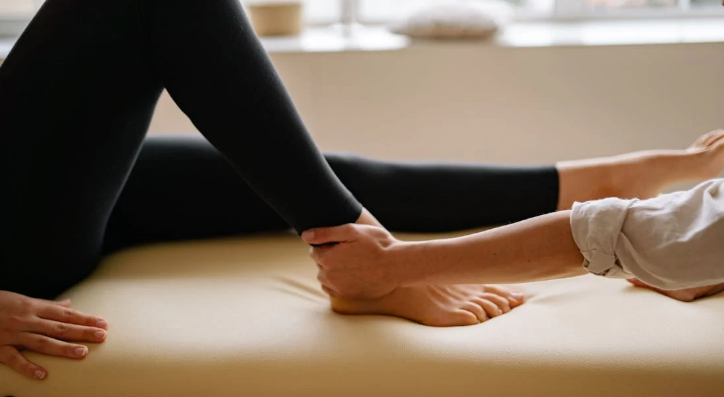Imagine a world where every athlete harnesses the power of touch to elevate their performance, speed up recovery, and prevent injuries. While rigorous training and proper nutrition are often at the forefront of athletic success, there’s an unsung hero in this narrative—sports massage. Delving into the intricate science behind this therapeutic practice reveals not just its benefits but also why it should be an essential part of any athlete’s routine. Whether you’re a seasoned pro or just starting your fitness journey, understanding how sports massage works can unlock new levels of physical prowess and mental clarity. Join us as we explore the fascinating intersection of anatomy, physiology, and sport to discover why integrating sports massage might just be your next game-changing strategy!
Introduction: explaining the purpose of the blog and its relevance to athletes
Every athlete knows that training hard is only part of the equation for success. The other essential component? Recovery. As the sports world evolves, so do the techniques used to enhance performance and speed up recovery time. One method gaining traction among athletes of all levels is sports massage. But what exactly is it, and why should every athlete consider making it a regular part of their routine? This blog delves into the fascinating science behind sports massage, its benefits, and how it can help you reach your full potential on and off the field. If you’re looking to boost your performance while keeping injuries at bay, keep reading!
What is Sports Massage?
Sports massage is a specialized form of bodywork designed to enhance athletic performance and recovery. It focuses on manipulating specific muscle groups used in various sports, which helps improve flexibility and range of motion.
The roots of sports massage trace back centuries, integrating techniques from ancient civilizations like Greece and China. However, its modern evolution began with the rise of organized sports in the 20th century.
Practitioners tailor each session based on an athlete’s needs—whether preparing for competition or recovering afterward. This personalized approach considers factors such as sport type, training intensity, and individual physical conditions.
Ultimately, sports massage serves as a vital tool for athletes looking to optimize their efforts while minimizing strain or injury risks. Its blend of tradition and science continues to shape how athletes integrate it into their routines today.
– Definition and explanation of sports massage
Sports massage is a specialized form of bodywork tailored for athletes. It focuses on the muscles and soft tissues that are particularly engaged during athletic activities.
Unlike traditional massages, sports massage employs techniques designed to enhance performance and aid recovery. Whether preparing for an event or recovering afterward, this type of massage targets specific areas based on an athlete’s needs.
The approach can vary widely depending on the sport and individual requirements. Techniques may include stretching, compression, or friction movements aimed at improving flexibility and reducing muscle tension. Ultimately, sports massage aims to optimize athletic performance while minimizing the risk of injury. It’s not just about relaxation; it plays a critical role in an athlete’s overall training regimen.
– History of sports massage
The origins of sports massage can be traced back to ancient civilizations. The Greeks and Romans recognized the benefits of bodywork for athletes preparing for competitions. They used techniques involving rubbing and kneading to enhance performance.
In China, traditional practices like Tui Na date back thousands of years. These methods emphasized energy flow and balance, providing a holistic approach to recovery and preparation.
As time progressed, the modern concept of sports massage began taking shape in the 19th century. Physical culture movements in Europe popularized various therapeutic techniques among athletes. By the late 20th century, as competitive sports evolved, so did massage therapy’s role within them. Sports teams started employing trained therapists specifically focused on enhancing athletic performance through targeted bodywork.
Today, this practice has become an integral part of athletic training regimens worldwide. Athletes now recognize its pivotal role not only in enhancing skills but also in maintaining long-term health.
Benefits of Sports Massage for Athletes
l Athletes often push their bodies to the limit. Sports massage can play a crucial role in enhancing performance.
l One of the primary benefits is improved endurance. The targeted techniques used in sports massage help increase blood flow, delivering more oxygen and nutrients to muscles during activity.
l Faster recovery time is another significant advantage. Massage aids in reducing lactic acid buildup, which can lead to soreness after workouts or competitions. This means athletes bounce back quicker, ready for their next challenge.
l Injury prevention is essential for any athlete’s longevity. Regular sessions help identify tight areas that could lead to injuries if left untreated.
l Additionally, stress relief cannot be overlooked. The mental pressures of competition can weigh heavily on an athlete’s mind, and a good massage provides relaxation that contributes positively to focus and mental clarity.
– Improved performance and endurance
Sports massage can play a significant role in enhancing an athlete’s performance. By promoting better blood flow, it ensures that muscles receive the oxygen and nutrients they need during intense activity.
As tension is released from tight muscles, athletes often find greater flexibility. This improved range of motion can translate to more efficient movements on the field or court. The techniques employed in sports massage target specific muscle groups engaged in training. This specialized attention helps prepare the body for high-stakes events, enabling athletes to push their limits safely.
Moreover, when fatigue is managed effectively through regular massages, endurance levels rise. Athletes discover they can sustain their efforts longer without succumbing to exhaustion, leading to improved overall performance metrics.
– Faster recovery time
Faster recovery time is one of the most compelling benefits of sports massage for athletes. Intense physical activity creates micro-tears in muscle fibers, leading to soreness and fatigue. Sports massage stimulates blood flow, which helps deliver essential nutrients and oxygen to these damaged areas.
This increased circulation accelerates the healing process, allowing muscles to repair more quickly. By reducing inflammation through targeted techniques, athletes can experience less pain post-exercise.
Additionally, massages break down scar tissue that may form during workouts or injuries. This not only enhances flexibility but also reduces stiffness. Athletes often report feeling rejuvenated after a session, ready to tackle their next challenge with vigor. The combination of relaxation and physiological benefits makes it an invaluable tool for anyone serious about optimizing performance.
– Injury prevention and rehabilitation
Injury prevention is a key component of an athlete’s training routine. Sports massage plays a vital role in keeping muscles flexible and strong. By targeting specific muscle groups, it helps to release tension that can lead to injuries.
When muscles are relaxed and well-maintained, the risk of strains and tears decreases significantly. This proactive approach allows athletes to push their limits without fear of injury. Rehabilitation after an injury is equally important. Sports massage aids recovery by enhancing blood flow to affected areas. Increased circulation delivers essential nutrients while flushing out toxins.
Techniques such as deep tissue and trigger point therapy focus on breaking down scar tissue, promoting healing faster than passive treatments alone. Regular sessions help restore function and range of motion with less discomfort during the process. Athletes can return to their sport feeling stronger and more resilient than before.
– Stress relief and relaxation
Athletes often push their bodies to the limit. This intensity can lead to stress, both physically and mentally. Sports massage serves as an effective tool for relaxation amidst rigorous training schedules.
The soothing techniques employed during a session help release tension stored in muscles. As the therapist works through tight spots, athletes experience a profound sense of relief. The body begins to unwind, allowing for deeper breathing and reduced heart rates.
Moreover, sports massage stimulates the production of endorphins—the body’s natural painkillers. These chemicals promote feelings of well-being, further enhancing mental clarity.
Incorporating regular massages into an athlete’s routine not only aids recovery but also fosters a calm mind. With improved relaxation comes heightened focus—essential for optimal performance on game day or competition time.
The Science Behind Sports Massage
Sports Massage goes beyond relaxation; it has a profound impact on the body’s systems. By manipulating soft tissues, it enhances blood circulation, ensuring oxygen and nutrients reach fatigued muscles efficiently.
The nervous system also benefits significantly. Techniques like deep tissue work release tension held in tight areas, which can alleviate pain signals sent to the brain. This creates a sense of relief that athletes often crave after intense training.
Different techniques cater to specific needs. For instance, Swedish massage promotes overall relaxation while trigger point therapy focuses on releasing knots in muscle fibers. Each method offers unique advantages tailored for athletic performance.





